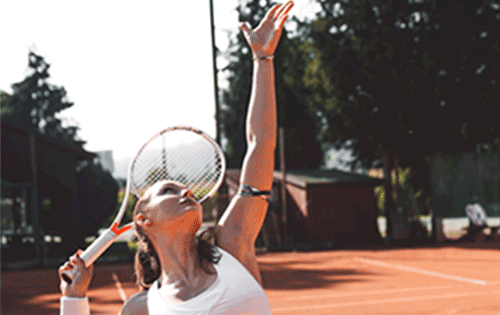Conquer Tennis Elbow: Your Comprehensive Guide to Physical Therapy for Tennis Elbow
Tennis elbow, medically known as lateral epicondylitis, is an all-too-familiar problem that many tennis athletes and other active adults (even many that don’t play tennis, ironically!) in every city struggle with from time to time. This condition, resulting from overuse of the forearm muscles and tendons, manifests as pain and tenderness on the outside of the elbow.
But if you’re struggling with tennis elbow, have some hope! With a thorough understanding of biomechanics and the right therapeutic approach, you can both prevent and effectively treat tennis elbow. Let’s dive into how our Rochester Hills, Michigan-based physical therapy practice uses its unique ‘Movement is Medicine’ approach to help you beat tennis elbow and get back in the game.
UNDERSTANDING TENNIS ELBOW: MORE THAN JUST ELBOW PAIN
Tennis elbow often arises from repetitive stress on the forearm muscles, typically from frequent tennis strokes, especially the backhand. This repetitive stress can lead to small tears in the tendons attaching the forearm muscles to the lateral epicondyle—the bony bump on the elbow’s outside. But it’s not just about the elbow; the biomechanics of your entire body can influence these stresses and strains. We commonly see that deficits in strength & control over the shoulder complex, torso (spine, pelvis, ribcage), and hips can cause higher-than-usual stress on those elbow tendons – so we want to make sure to address those areas as well to stay ahead of the game!
BIOMECHANICS: THE KEY TO EFFECTIVE LATERAL EPICONDYLITIS TREATMENT
Biomechanics, the study of the mechanical laws relating to the movement or structure of living organisms, is crucial in both preventing and treating tennis elbow. Proper biomechanics can distribute the load more evenly during tennis strokes, reducing elbow stress and, consequently, the risk of tennis elbow. This is where our ‘Movement is Medicine’ philosophy truly shines. We emphasize a whole-body approach to generate force, sparing your arm from excessive strain. We believe that working with a Tennis Pro or coach can do wonders to improve the efficiency of each of your strokes/swings — and it also goes a long way in improving performance as well!
GRIP RIGHT: AVOID TENNIS ELBOW
Your racket grip plays a pivotal role in managing the stress on your elbow. A grip that’s too tight increases the load on the forearm muscles, while a loose grip can lead to instability and increased wrist movement—both potential precursors to tennis elbow. Our physical therapy practice in Rochester Hills, Michigan, can guide you in finding the optimal grip size and strength to prevent tennis elbow.
REGIONAL INTERDEPENDENCE AND THE POWER OF THE ROTATOR CUFF
The concept of regional interdependence states that impairments in an anatomical region, even remote ones (for example, your single leg balance or lower leg strength & power), may contribute to the primary complaint—in this case, tennis elbow. Weaknesses or imbalances in the shoulder, especially the rotator cuff, can increase stress on the elbow. Therefore, rotator cuff strengthening forms an integral part of our comprehensive strategy for both preventing and treating tennis elbow.
BONUS SECTION: STRENGTHENING YOUR GRIP AND FOREARM – THE CORNERSTONE OF TENNIS ELBOW PREVENTION AND TREATMENT
As an add-on to what we have outlined above, let’s dive a bit deeper into a specific aspect of tennis elbow prevention and treatment: the importance of strengthening your grip and forearm.
THE POWER IN YOUR HANDS: GRIP STRENGTH AND TENNIS ELBOW

The strength of your grip is directly related to the health of your elbow when playing tennis. As we touched on earlier, an overly tight or excessively loose grip can contribute to the development of tennis elbow by increasing strain on your forearm muscles and tendons. In contrast, a strong, properly calibrated grip can help control the racket’s impact forces, reducing the chances of injury.
Grip strength exercises, such as dumbbell/barbell/kettlebell training or using a specific hand-grip exercise tool, can improve your grip strength and control, thereby decreasing the risk of tennis elbow. Consistent grip strength training can also help alleviate existing symptoms by strengthening the muscles and tendons involved and promoting better movement patterns.
ARM YOURSELF: FOREARM STRENGTH AND ITS ROLE IN PREVENTING TENNIS ELBOW
Your forearm muscles play a vital role in initiating, controlling, and then decelerating (slowing down) the movement of the racket during a tennis stroke. When these muscles are weak, they are more susceptible to the micro-tears that lead to tennis elbow.

Forearm strengthening exercises, such as wrist curls, reverse wrist curls, and forearm pronations (turning palm down towards ground) and supinations (turning palm up towards ceiling), can help build resilience in these muscles. Strengthening these muscles also helps distribute the force of the racket’s impact more evenly across the arm, reducing the strain on any one muscle or tendon. One of our favorite grip/forearm strength tools is the Theraband Flexbar (make sure you get a few different resistance levels). You can check that and our other favorite self-treatment products out on Amazon below!
Moreover, robust forearm muscles can improve your overall tennis performance, providing you with more power and control over your strokes. This not only lowers your risk of developing tennis elbow but can also give you a competitive edge on the court. There’s really no downside!
DRY NEEDLING: AN ADDITIONAL AND EFFECTIVE APPROACH

In our practice in Rochester Hills, Michigan, we also use dry needling as part of a comprehensive treatment plan for tennis elbow. This technique involves inserting a thin needle into specific areas of muscle tension or trigger points in the forearm. It can provide immediate relief of symptoms and complement the benefits of a regular strength training routine. You can read more about this breakthrough treatment here!
Remember, prevention is the best cure. By incorporating grip and forearm strength training into your routine, you’re not only setting yourself up to prevent tennis elbow, but you’re also likely to see improvements in your overall tennis performance.
However, it’s always important to consult with a healthcare professional or a physical therapist before starting any new exercise regimen. If you’re looking for tennis elbow treatment in Rochester Hills, Michigan, don’t hesitate to contact us for a personalized treatment plan that includes strength training, dry needling, and advice on grip and stroke technique.
To conclude, preventing and treating tennis elbow isn’t just about addressing the symptoms—it’s about improving your overall performance and understanding of how your whole body works together. By comprehending tennis biomechanics and making necessary adjustments, you can protect yourself from tennis elbow. We encourage consulting with a healthcare professional or a physical therapist for a comprehensive evaluation and treatment plan.
Our next article will delve deeper into specific exercises and techniques for preventing and treating tennis elbow, so stay tuned. In the meantime, if you’re seeking tennis elbow or lateral epicondylitis treatment in Rochester Hills, Michigan, don’t hesitate to reach out to us for specialized, comprehensive care.
Remember, “Movement is Medicine” and we’re here to dose it just right for you!


